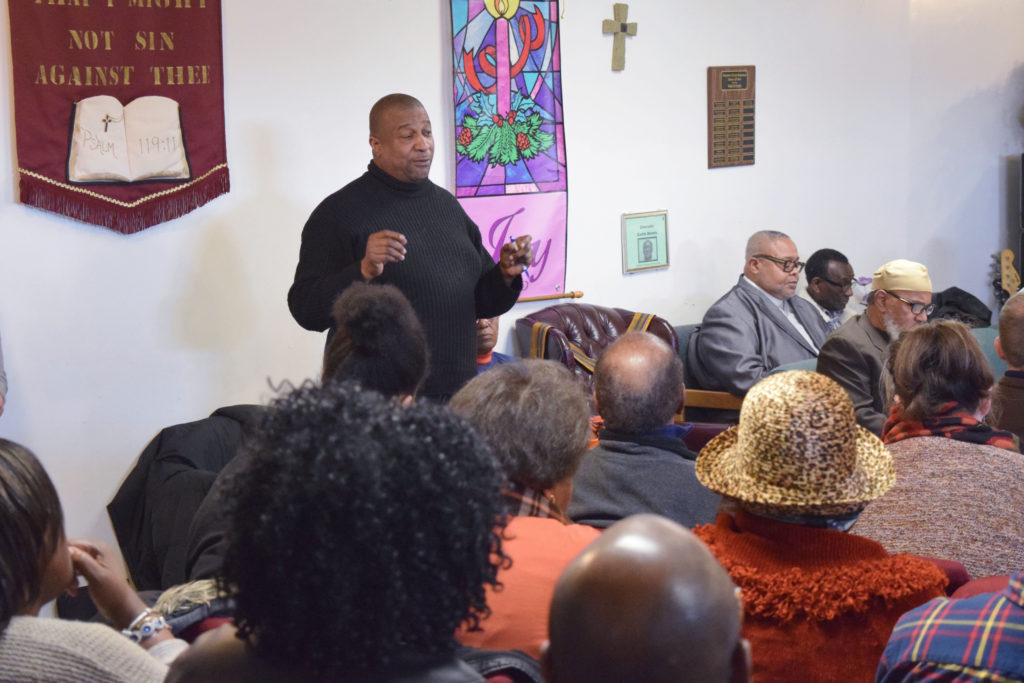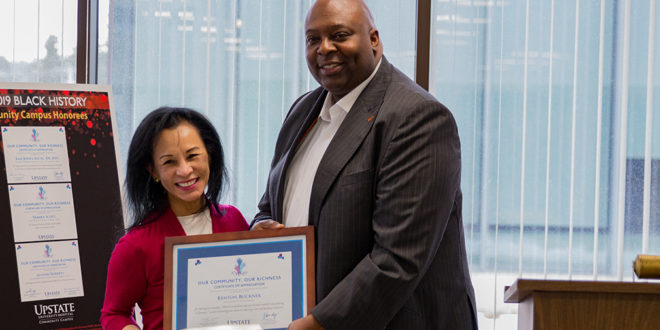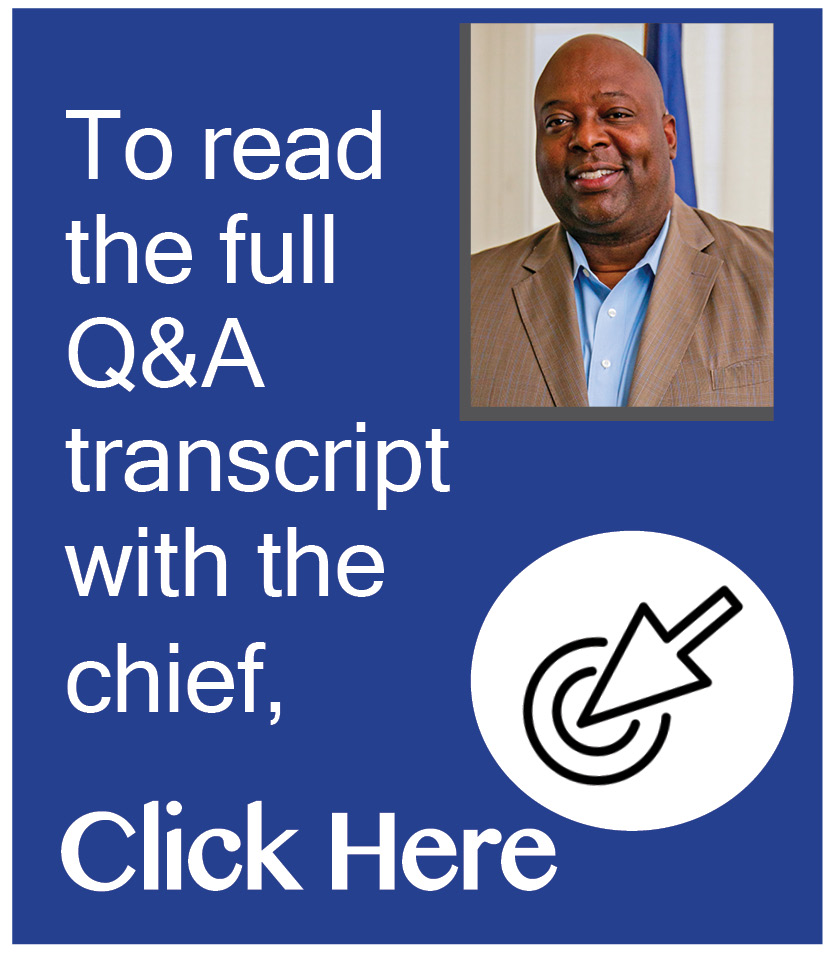Part 3 :: Plans for Syracuse
In this third part of our four-part Q&A series with Syracuse’s new police chief, Kenton Buckner shares how he will approach the coming years. On questions of policing, policy and community, Buckner answers comfortably and in detail.
He was the son of an officer — though Buckner says he did not know his dad well — and Buckner himself always wanted to be in law enforcement. His experiences with police were positive. But he says he understands others — particularly some African-Americans — have reasons to mistrust.
Q: You mentioned you’d be here perhaps 3 to 5 years, and that’s what the data shows. That’s not long. Is that something you think you’ll hear about from lifelong community members?
A: I hear a thousand things from the community. I think that people want you to come to work and give them an honest day’s work for an honest day’s pay. I think they’d like to feel like you’re committed to both the job and the community and that you are open and honest about the business that you are doing. I believe that most people understand that chiefs don’t last forever, that this is a tough business, that there’s a reason chiefs last three to five years in most cities.
What are your top three priorities? I think you have mentioned curbing violence in the community, more diversity on the police force and creating partnerships in the community?
A: Those certainly are priorities. Those are pillars of public safety. Violent crime is something that we have to attempt to manage. It’s part of the fear of crime, it’s part of perceptions of your city, it’s a part of the trauma when you actually have violent crime in communities. It’s a part of historical scars in cities that are crime-infested, that have those historical issues of homicides, aggravated assault, where people don’t feel safe in their community despite what your crime data tells you — that you had a decrease in crime one year or so. But if you go into communities where they hear shots fired every night, they don’t want to hear about your numbers because they’re still lying on the floor in their houses and apartments.
Our police department lacks diversity as it relates to reflecting our community both in the rank of officer, which is the entry-level part of this organization, and then at the command level there are no minorities where I believe, it is my understanding, there is one gentleman that identifies as Native American in the entire command structure, with the exception of myself. That’s unacceptable. I don’t know how it happened but I know I’m responsible for it today, and I am going to do everything within my power to attempt to address it in the right way going forward.
Q: About 10 percent of Syracuse officers are African-American. Do you have particular strategies to increase that number?
A: I’ve taken a direct seat at the table for the application and hiring process so that if there’s someone who does not make it in our process — meaning the background investigations or anything where decisions are made on the administrative side of the process — I’m intimately involved with that to make sure we’re doing the things that I feel give us an opportunity to be competitive with all races. We want quality people first but we certainly want to be reflective of our community. We believe that’s equally important.
And then to develop external partners to recruit minorities. Recruiting is not a police issue, it’s a community issue. One of the examples of that is where we plan to partner with the NAACP going forward to help with the written exam, and get other organizations involved. Think of what myself, police, fire and civil service can do to offer study sessions for individuals or preparatory work for the written exams, open to the entire public but certainly with a keen focus on trying to get minority candidates through that initial threshold. It’s well-documented that minorities — not just minorities, many individuals — struggle with written exams, so we think that will help.
Continuing to work with youth before they become adults, like through the (Public Service Leadership Academy at Fowler) vocational program for criminal justice to formally bridge a relationship with that organization so that we will be able to effectively grow our own fruit, and from that we hope to wrap our arms around these freshmen through senior years that are at an impressionable time of their lives to attempt to keep them on the right path until we can get them to age 21 and through the doors of the Syracuse Police Department. That method will not bear fruit immediately but we think it’s an investment that’s worth doing.
And I’m also reviewing adding an assessment center to the promotional process (for existing officers) so that a written exam is not the total score but part of a composite score that allows an individual to demonstrate that they can apply many of the things that someone can read in a book, for people who won’t do as well with a written exam but will perform better in an assessment center where you actually apply the concepts you’ve been asked about. We think that will help with the promotional process.
And then we will use the consent decree (which requires municipal officials to take race into account in hiring) as a tool that was designed to be used — I think it’s been in place for the past 39 coming up on 40 years — and use it the right way. … And anything else we can do, of course being legal and passing the “reasonable” test, to try to diversify this police department.
Q: Do you think about race and how it seems, inevitably, to be a part of everything?
A: Yeah, I know, but it’s monumental. If you’re a part of that minority group that is standing on the outside looking in, then it’s the elephant for you. If you’re part of the majority that’s in the room and you get to determine who walks into that room, then it’s peanuts to you. But I have to approach it as if it’s the elephant in the room because clearly our community is frustrated with it, our mayor has made it part of his charge to diversify all of city government, and certainly no department is probably more visible than the police department and he probably hears about the lack of diversity in the police department more than any other department in city government.

Q: I do know the “trust thing” is huge. Just getting people to apply to be a cop.
A: Well, law enforcement is a difficult sale in black and brown communities. There are significant present and past scars in those communities, and many believe that those scars were inflicted by public safety, law enforcement, government. In some examples, it’s perception and in some they have tangible examples to prove their lack of trust. I inherit those relationships, that lack of trust, whether I was on the watch when these things happened, I inherit that when I walk in the door. Again, that’s an elephant in the room that I have to address because that mistrust exists today. So when I’m trying to recruit that 21-year-old kid to come and join us on the police department, he or she may have some issues in their rear-view mirror to where they’ve seen the police do some things that are disturbing to them. I have to overcome that to inspire them to be a part of what policing can be or what it should be. And to be a part of the solution for Syracuse. That’s no easy feat.
Q: What does this concept of “community policing” mean to you?
A: I think that people have become very familiar with community policing as a buzzword or catchphrase. To me, community policing is when you’re able to provide tangible examples of prevention, partnerships and problem-solving. That’s community policing in a nutshell. You’ll find a hundred different definitions of it if you look it up, but if you don’t have partnerships with the community, and you’re not preventing crime and solving problems, I really don’t think you’re doing community policing … And (you need) tangible examples of it because, you know, I’ve been to several meetings where I’ll tell individuals that if we came here to say that we’ve met, we’ve wasted everyone’s time. What are we going to have as a result of this meeting? I think that communities that have not understood the meaning or the importance of collective impact … continue to be frustrated by some things that are going on. The example that I would use is that if you go into communities that have a private high school or they have a church or something that’s very, very dear to their heart, you will not see a liquor store next to that. Some communities won’t allow it to happen. And there are some communities that will be frustrated by it but they allow it to happen every day. That’s the difference between action and meeting.
Q: One thing in relation to the community concept is small satellite police offices in neighborhoods.
A: We have different locations throughout the city where our officers will go, the various community centers that we have, the one in Westcott, the Southwest Community Center, officers are in and out of there, we’re in the schools. An organization that I had a great relationship with in Little Rock that I want to improve our footprint with here is the Boys & Girls Clubs. We’ll see some of those things in the summer months. We will be back at the city pools this year. We had kind of pulled away from that last year, and there were some issues as a result of it. So anywhere we have an opportunity to constructively come in contact with youth you will see a robust effort on our part.
Q: What was it about city pools?
A: It was basically a shortage of officers at a time when the summer months are very difficult for us to cover — the amount of calls and challenges that are going on in the summer months — and I guess that was one of the details or initiatives that they had to cut back on because of the challenges that we’re facing on the streets. We just learned that because many of our school-age kids are at those pools, and with some of the challenges that reared their heads last summer, we want to make sure we get on the front end of it this year and have a police presence there for visibility and to deter any kind of distractions or fights or anything like that that may be occurring.
Q: Any other concrete plans that folks might look for in the future months that also relate to this kind of community policing?
A: Well, the police officers in the community policing unit now are centralized. We’re decentralizing that area of the agency and other areas of the police department. We’ll be rolling that out over the next month or so to kind of give the community an idea of how the agency will look decentralized.
Q: What does that mean?
A: Now, all of us report out of one location off of Erie Boulevard and our captains, who in my opinion are the first level of executive leadership, are on a shift (around the clock). We are going to move the captains to day hours, the kind of hours I work, and now they will be responsible for three different sections of the city that we’ve divided the city into, and they are responsible for those geographical areas 24 hours a day. In addition to that they’ll have the community police officers that were once centralized under our administrative bureau now assigned to the patrol commanders who will then deploy them for some of these community policing initiatives — many they were already doing but will now do in a more organized way in these three central areas that we will have, which will be the north, southwest and southeast of our city.
In the new way, they will not be on a day shift, mid-shift, late watch, which to me took power and authority away from them. They will be working the primary business hours that I work, kind of the day hours into the evening. Business time during the day, community connection during the evening. And they will be in a specified area; now we’re broken up into 22 territories, but we’re just one city is how we’re deployed. Tomorrow, which is our new way, we will be this (in three areas): Captain, captain, captain. … Right now we don’t have this level of contact with the public. Every citizen should know who their captain is that’s responsible for their neighborhood.
We will roll it out in community meetings (by the end of March).
Q: And anything about opening these smaller kinds of “satellites,” offices around the city?
A: That’s kind of a midterm move that we would like to see. Maybe police in a substation or something actually in the areas rather than centralized like we have on Erie Boulevard. But we have to remember, too, that we are only 25 square miles so we have to look at the financial feasibility of that and what is our gain for that in exchange for the cost that we would incur.
Q: What about the Crime Reduction Teams. Is that something you’re going to continue, constituted as they are now?
A: We’ll continue to have that mission. It’s important that you have a unit that is able to go into areas based upon intelligence-led policing, to address the right locations and focus on the right individuals in those areas. I have to make sure that we’re doing that in a way that we’re not unintentionally harming the community, because I’m also well aware they (CRTs) have been the source of some complaints, and some of the mistrust in the community. So I have to make sure we’re doing business the right way. That’s a part of my job, to make sure we’re training folks the right way, that we’re hiring the right people, and that we are providing public safety efforts in a way that is seen as respectable by the citizens that we’re trying to serve.
Q: So this is something you’re looking at and might change?
A: The mission won’t change. I’m a person who believes from time to time you need to switch individuals out so I may have some leadership changes at some point with that, but that’s not a reflection of a person not doing anything. I believe there is value in moving people around, so that will be maybe some change we see sometime in the future. But for now, we certainly will continue to press forward with that unit.
 The Stand
The Stand



